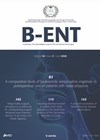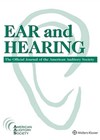
Journal Reviews
Persistent postural-perceptual dizziness (PPPD), psychosomatic or not? The debate continues
PPPD continues to provoke debate since the diagnostic criteria emerged in 2017. This review covers two commentaries because they are best considered together: the first one, by HK and BS-U, concluded that PPPD is a psychosomatic disorder (in fact, ‘a...
Paediatric vestibular dysfunction
This Malaysian study looked at the awareness amongst otorhinolaryngologists in the investigation and management of paediatric vestibular dysfunction. The authors noted that, although paediatric vestibular dysfunction is a common problem, there seems to be limited literature in assessing the proficiency...
Cognitive function is preserved in episodic vestibular disorders
Cognitive deficit in bilateral vestibular failure in particular, but also in unilateral vestibular failure, is well documented. The authors designed this prospective study to determine if deficits in cognition, as well as anxiety and depression, were present in episodic vestibular...
Polypharmacy in the vestibular clinic
Polypharmacy is defined as the simultaneous use of five or more medications and its prevalence is increasing. Dizziness or vertigo are common side effects of polypharmacy. Despite advancements in patient data management, there remains limited information on polypharmacy in patients...
Cervicogenic vertigo, a view from the experts
Many readers would be familiar with the term ‘cervicogenic vertigo’ to mean neck-related vertigo or dizziness. In simple terms, this disorder has been defined as dizziness/vertigo caused by neck pain and/or stiffness. By implication, the vertigo/dizziness should resolve by treating...
Measurement of HINTS in peripheral vestibulopathy
Dizziness; Head impulse test; Nystagmus; Skew deviation; Vertigo.
Subtypes of vestibular migraine
The authors argue that the current Barany criteria (ICVD) for vestibular migraine (definite and probable – dVM and pVM) are too restrictive. For instance, whereas a category of chronic migraine with or without aura is recognised in ICHD-3, ‘chronic VM’...
Impact of vestibular rehabilitation on patients with peripheral vestibular disorders
Vestibular rehabilitation is a widely used treatment for vestibular dysfunction. It can improve dizziness, fall risk, balance, and emotional status. However, some patients do not get benefit from vestibular rehabilitation. In this study, the authors assessed the impact of dizziness...
Corticosteroid prescribing in ENT - are we at risk of being sued?
Of medications leading to malpractice claims, corticosteroids comprise the third most common. They are used widely and have a significant side-effect profile: hypertension, lipodystrophy, diabetes, avascular necrosis of the femoral head, peptic ulceration and psychiatric reactions to name but a...
Unravelling the Meniere’s vs. migraine conundrum – what does the mastoid contribute?
This is an interesting observational study that attempts to classify subtypes of Meniere’s disease (MD) in relation to the coexistence of migraine. It is well known that the two conditions share common characteristics, making diagnosis and treatment challenging at times....
Transmastoid facial nerve decompression for persistent traumatic facial nerve paralysis
Facial nerve paralysis (FNP) can occur following trauma, with a small number of these patients requiring facial nerve decompression (FND) to aid recovery. The authors shared their experience in decompressing the facial nerve for persistent severe FNP via a transmastoid...
Persistent imbalance after traumatic brain injury is central in origin
Several residual symptoms, including dizziness and imbalance, can follow traumatic brain injury, no matter how mild. This study focused on the mechanisms, peripheral and central, underlying the complaint of persistent imbalance in patients with chronic mild traumatic brain injury (mTBI)....














